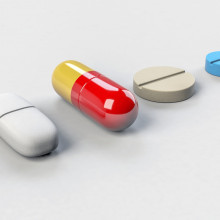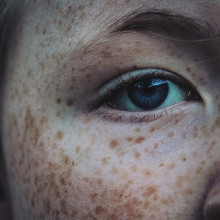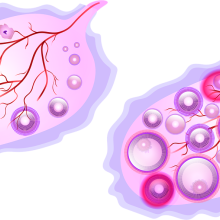How many friends for best brain health?
This month join host Dr Chris Smith to hear how a nuclear power station provides the opportunity to test theories of the effects of global warming on how fish grow, evidence that personalised medicines have an added placebo effect, the genes for skin colour and skin cancer, why five friends is optimal for best brian health, and the role of the immune system in the ageing ovary...
In this episode

00:37 - Nuclear Fish on Heat
Nuclear Fish on Heat
Max Lindmark, Swedish University of Agricultural Sciences
But first, warmer conditions, including those produced by climate change, are known to affect the rates at which some fish species grow, and how large they ultimately become. This could affect food chains, because if animals mature at different times and reach different sizes, former food sources may no longer be suitable. As Chris Smith hears, these temperature effects are hard to test in the real world though, unless you’re Max Lindmark, from the Swedish University of Agricultural Sciences…
Max - A common problem in many studies where we want to look at fish growth rates and body size in the world is that we don't have a very large temperature contrast yet. I mean, there has been warming for decades, but to detect any signals on fish, you would prefer a larger sort of gradient of temperature that you're evaluating against. And we are fortunate enough to have a study system on the coast of Sweden where we have a nuclear power plant that takes in water from the coast. And when they built this in the 1980s, they wanted to investigate the effects of warm water pollution from nuclear power plants. So they took the water that was heated by the nuclear power plants and they didn't release it just on the coast, but they built a manmade lake and put all the warming water in there. So that lake has been, since the 1980s, about five to 10 degrees warmer on average than the surrounding area. And what they did that was really good was also that they did test fishing both outside the reference area and within the lake to see, like, how much fish do we catch? How big are they? How do they grow? So we have this unique time series of 24 years of data.
Chris - But all the other factors remain relatively comparable, as in it's the same geography, it's the same fish, it's the otherwise the same section of coastline. It's chiefly the temperature that differs between the two sites?
Max - Yeah. So it was the same population and then they just enclosed a little bit of it.
Chris - And what's that done to the fish?
Max - They grow faster. The warming has probably led to a longer growing season. So fish, they don't grow when it's too cold. And in temperate regions, like in our part of the world, they grow in the warm summertime. So with the longer growing season, they can grow for longer to reach a larger size. They also grow faster in this time, so they reach a larger size. At age, the mortality is also higher. So fish die at a younger age. We don't have as many really old fish in this lake. And the third response that is very clear is that they also reach a bigger size in this heated biotest lake that we call it.
Chris - It's almost like the fish equivalent of being a rock star - I suppose you could say a "rock pool" star - they live fast and die young, but also big!
Max - Yeah, exactly! It is really a faster sort of pace of life in this warm lake.
Chris - Are we comfortable that there's no impact other than the temperature? I mean, many people are sensitive to nuclear power and so on and the environmental impacts of that. It's one of the most regulated and one of the safest industries, but there are accidents. There are also discharges and leaks. Nonetheless, are we comfortable that that is not in any way playing a role here?
Max - I would say this is a fairly small lake, one kilometre across and during its lifetime it's seen a lot of stress. Let's say that. For instance, once a seal came into this lake and it would just eat so much fish. You've had time periods of quite large survey catches. You've had stocking of eel, you've had a total wipe out of benthic production. So we had all these very large disturbances in the system, but you don't pick up those signals in the growth data.
Chris - The temperature difference that you're dealing with is very large and way beyond what we expect on average across the planet. But do you think you're therefore seeing a bit of an artificial situation here or are we expecting some patches of the Earth's oceans to, to change in temperature by this extent because of climate change?
Max - This is a very extreme warming scenario. The lower end of the temperature difference that we observe is probably not too different from what we're seeing in the Arctic sometimes. And not in the too distant future. The warming in the world is very heterogeneous. Some areas are warming much faster and others are not warming that much.
Chris - What might be the implications of what you found then? If we extrapolate from this nuclear pond to the world's ocean systems, what could the effect of what you've seen if it were more manifest more widely across the ecosystem?
Max - First of all, with faster growth rates, species interactions will happen faster. Predation flow of biomass through the ecosystem might be faster in terms of fish. If they grow faster, they can sustain a higher fishing mortality. But on the other hand, you might then also not catch as much because the sort of background mortality also increases as we show here.
Chris - Could there be knock on ramifications where if some species are more sensitive to these effects than others, you could get animals that grow at different rates and animals that feed other animals are therefore becoming too big to be eaten by things that would previously be preying on smaller feed. So could there be knock-on effects beyond just the physical growth rates?
Max - I think so because large fish or large organisms eat small organisms when they're born, they eat zooplankton and they need to be within a specific size window because they can fit perfectly in, in a small larvae mouth, for instance. So it's very important that you always have prey of a specific right size as you go and grow through life. And if you start seeing these mismatches where they don't have the right prey to feed on, that can have sort of knock on effects.

07:09 - Placebo effects and personalised medicine
Placebo effects and personalised medicine
Dasha Sandra, McGill University
Placebo is Latin for, “I will please.” It’s also the name given to the effect where a person’s expectation of a positive outcome from an intervention produces a real clinical benefit despite the absence in some cases of any “real” therapeutic content. Literally, telling someone they’re going to feel relief from a painkiller produces analgesia even if you just inject them with saline. But in the era of personalised medicine, where treatments are tailor made to patients, might - Dasha Sandra wondered - there be an additional placebo effect just because someone regards the treatment as personal and therefore a bit more “special”. The answer is, as she explains to Chris Smith, there is!
Dasha - We went first for a proof of concept in the lab with healthy participants. We invited people to the lab for a pain study where they received heat stimulations on their forearm multiple times. And on half of those stimulations, they received a machine that they could use to reduce their pain. So this was presented as an analgesic machine, but in reality it was a placebo. And for half of those participants, we made them believe that it was personalised. And for the other half we told them that it was generally effective and used in hospitals. And to personalise it, we went through this very elaborate procedure with multiple sham tests and false feedback that we pretended to apply to the machine so that they really saw that it was personalised to their genetics.
Chris - And the outcome measure was how much heat you could apply to them before they said 'Ouch!'?
Dasha - We applied the same level of heat that they rated as, for example, level 6 out of 10 pain. And they would rate that pain intensity. So they would say yes, this felt like a 60 out of a 100. We gave them the same heat stimulation, both on the trials with and without the machine. And then we compared when they were using this placebo machine, they actually rated their pain intensity as lower.
Chris - How much of an effect was there when you said to the people who were getting the personalised - let's call it that the "personalised" pain relief - you're going to get pain relief. Now, how much less pain did they feel compared to people who just thought the machine was there for some pain relief?
Dasha - So close to six points reduction on a scale of a hundred, which was relatively small in sort of general terms, but if you compare it to the control condition where they thought that it was generally effective, there was no pain relief there. So comparatively it was a lot larger.
Chris - That's an average though, I presume, isn't it? So were there any people in the study - because we're talking here about personalised medicine! - were there any people for whom this particular thing appeared to be extremely effective and some for whom it was less effective?
Dasha - Yes, absolutely. So there may have been some personality effects that contributed to some people benefiting from this sort of quote unquote 'personalisation', more so there was one personality trait needed for uniqueness or the desire to be seen as different from others that had this kind of moderating effect. So people who wanted to be seen as different and scored high on that benefited from the treatment the most if it was presented as personalised to them.
Chris - And, considering the mechanism, I mean obviously that's not what you set out to find, you were looking at the impact of the intervention rather than how it might be working, but is this just an extension of the placebo effect in the same way that if I give you an injection, I tend to get more of a dramatic response reported by you than if I feed you a pill or rub your back or something. Is it that people think because it's an enhanced intervention, it produces a greater effect? Is that how you think this works?
Dasha - It could be. There are several possible ways that it could be working, and that is something that we need to understand further. So in this particular study, we really went with a very precise purpose to find "does this exist" - does the allure of personalisation contribute to the placebo effect? And we found that it did. Now, whether this is a different type of placebo effect or whether there was a compounded interaction with other contextual factors is sort of up for debate right now. We think that this is a different kind of placebo effect that was specific to personalisation, but it is only the first study. And so we would definitely need to look more into the mechanism.

12:29 - Genes for skin colour and cancer
Genes for skin colour and cancer
Khai Ang, Penn State University
Human skin comes in many different colours, which, of course, is underpinned by our genetics. But disentangling which genes are involved, and which, if any, of those also help to protect darker skin against cancers like melanoma is an open question. This is particularly interesting when you compare east Asians and Europeans, who are both relatively pale skinned, but affected by skin cancer to significantly different degrees. It’s not straightforward to study though, because genetic “admixture” over the centuries has introduced a whole host of genes that might be responsible. But, speaking with Chris Smith, Penn State’s Khai Ang realised that there might be a way to study this thanks to a community in the Caribbean with strong, relatively pure Native American ancestry who are descended from the east Asian migrants who first populated the Americas thousands of years ago…
Khai - What are the genes that play a role in the variations of skin colour in the East Asian population? The bigger question that I'm asking is why melanoma is 20 times higher in people of European ancestry versus East Asian people, although we are both considered to have light skin.
Chris - And how did you try and get at that then?
Khai - One of the key things that is important is to look at the populations around the world. And as we look at human migrations from thousands of years ago, people migrate out of Africa into East Asia and then across the Bering Strait down to the Americas. So I started looking at human migration maps and we identified populations in the Caribbean region and we ended up in Dominica and they have a Native American territory and they are more isolated from the rest of the new world population. So what it means is that they will have a higher Native American ancestry.
Chris - Why does that matter though? If you can just go and look at people from East Asia and they share a common ancestor with these Native Americans, why do you need a relatively pure or as pure as you can get stock of Native Americans to study?
Khai - Great questions. So one of the things that are about skin colour is that there are multiple genes affecting skin colour. However, I'm interested in one of the primary genes that's playing a role. So in order for me to look or test the effect of this primary gene, I have to eliminate all other genes. So when I look at the East Asian populations, for example, I cannot use them because there are so many other genes that play a role in the East Asian skin colour. I have to look at human populations that have African ancestry and also East Asian or Native American ancestry. And this is where the Kalinago population from Dominica comes in.
Chris - How did you then use their DNA in order to work out the answer to your problem?
Khai - We collected samples from the Native American people and we also measured the skin colour reading of these people. And then we plot that graph looking for people of the lighter skin and also the darker skin. And we extracted DNA from this group of people from the darker skin colour and the lighter skin colour. And after that we sequence them and we look for changes in the DNA that are specific to one group and not to the other group.
Chris - And have you managed to pinpoint the genes which appear to be doing this accounting for these differences in skin tones?
Khai - We unfortunately have not identified a specific gene, but we have managed to quantify the effect of Native American ancestry towards the skin colour. So the genetics of Native American ancestry contribute at least 20 melanin units to differences in the skin tone of the Native American populations. Right now we are trying to narrow down genes that are playing a role in these populations.
Chris - And going back to your starting premise, which is we want to understand why there are differences in risk of melanoma in different populations, how much further does this finding take us along that road?
Khai - One of the things that we need to do is to be able to identify populations suitable to be used to identify the genes. So we are at least one step closer towards answering the questions of what genes play a role in melanoma. We need to first identify the genes that play a role in skin colour, and then we go down to biochemical pathways. So at least one step closer.

17:20 - How do friends affect our brain function?
How do friends affect our brain function?
Chun Shen, Fudan University
It goes without saying that friends are very important to us, and we begin to establish friendships from a young age. This influence provides a massive stimulus for brain development. But how does it affect the brain, and what’s the ideal number of friends? As she explains to Chris Smith, by looking at data collected from thousands of children, correlating cognitive abilities with imaging results and the number of friends each has, Fudan University’s Chun Shen has found that up to 5 appears to be ideal. Beyond 5 friends, there are no more benefits to mental health or cognitive abilities. Instead, the reverse may be true: keeping up with too hectic a social life may prove destructive…
Chun - Children, in late childhood, the influence from peers and friends becomes more and more important for children's health and cognition. So we are very curious about whether having more and more friends is necessarily better for children. So there are two main aims, whether more close friends is better or not, and there's the potential mechanisms underlying these relationships.
Chris - How did you explore both of those things?
Chun - We think if we want some very solid conclusions, we need a big data set. So first we used the Adolescent Brain Cognitive Development study, which included 7500 children, nine to 10 years old. And in this dataset they have very rich behavioural measures and also bring major measures. So we can use this data set to investigate the relationship between close friendships and mental health and cognition. And we also can use this data to explore the relationship between close friendship and brain development.
Chris - Naturally this is an observational study, so what you are able to say is we can look at how many friends a person has and we can look at the brain imaging and we can draw associations between the two. But I suppose what you can't say is whether one begets the other, it's chicken or egg. Did the brain changes make the social changes or did the changes socially have more or fewer friends then? Because the brain changes.
Chun - Yes, yes. Essentially it is observational study, so can't make conclusions. I agree with you.
Chris - Nevertheless. What were the relationships that emerged when you looked at this? It's a very big group of individuals that you've been able to look at. What were the relationships that you saw between brain changes and friendship and social circumstances?
Chun - We foound non-linear relationships between the number of close friends and mental health, especially social and attentional problems and cognitive performance intelligence.
Chris - Is there a sweet spot then, a certain number of friends which, up to that point, you get good results from? And then beyond that things level off or get worse? How does the graph look if you drew a graph of benefits versus disbenefits and the number of friends? What does the graph look like?
Chun - Our study, we found that the positive relationship between close friends and mental health diminished beyond five close friends. And for cognitive measures beyond five close friends, the relationship became negative, which means more close friends, worse cognitive performance.
Chris - Do you know why the number five appears to be special here? It's interesting, isn't it: we've got five fingers, five toes on each limb. And also if you ask people to look at a picture and estimate how many things that there are in it, we're very good at guessing up to five and beyond that things get more tricky. Is there something special about the number five in the human brain then?
Chun - We also think the number of five is very interesting. I think this makes sense because too few friends means that you have no one to interact with. If some of them are busy, too many friends probably means they are not very closely connected to you. There's maybe a trait of between the quantity and quality of friendship networks spending too much time on social activities may lower your academic performance.
Chris - Do we know, if you look at the brain imaging, how these friendship groups and access to friends and social networks affects or appears to affect, notwithstanding the fact that we're only making an observational association here. But how does the number of friends correlate with the brain structure in these individuals?
Chun - The relationship between close friendship, quantity and the brain structure is very similar to the nonlinear relationship between the number of close friends and mental health. We found a strong relationship between close friendship, quantity and social brain regions, which means that these brain regions are responsible for social processing. However, the positive relationship diminished when the number of close friends exceeds around five.

23:04 - Inflammaging
Inflammaging
Yoni Savir, Technion, Israel
Inflammation, and how the maturation of the immune response is linked to the ageing process is a key area of study. One place where this really matters is in the ovary, which goes through repeated cycles of inflammatory changes with each ovulation. And, as he explains to Chris Smith, that’s what Yoni Savir, from Israel’s Technion has been looking at…
Yoni - What we wanted to understand is whether the ageing of the immune system is different in the period where the female is fertile compared to the period where she's not. And in mammals, in female mammals, we have a good system that actually divides the life of the female to a fertile period and non fertile period. There are some general ageing processes in all the organs, but we wanted to zoom in on the ovaries because they play a critical role in the fertility process in particular. While the female is fertile, it undergoes cycles that are actually periods of inflammation. So, therefore, looking at this may help understanding whether there is a failure of the immune system within this particular organ, this is crucial for fertility is extremely important.
Chris - Let's just expand on that briefly because it may sound a bit counterintuitive to some that you have an organ that you want to make inflamed, but when an ovary goes through a cycle of maturing eggs and then ovulating them, there is inevitably this inflammation that happens. When that occurs, are you arguing then that we don't really know whether that inflammation is good or bad or how it changes and it's those factors solving those unknowns that we really need to get to the bottom of, to understand the ageing process in the ovary?
Yoni - What we want to understand is how does the immune system respond to these continuous cycles? So what happens in ageing in general is as the organism is getting older, the ability of the immune system to regulate itself goes down, and as a result there is an overshoot and excessive response to inflammation. So if we have some inflammatory challenge when we are young, the immune system can regulate it very, very easily. But in old people, when you have an inflammatory challenge, the immune system responds without regulation. And what we asked ourselves, do we see the same process, which is called inflammaging in the ovary? Because if we do see inflammation there, if this hypothesis is right, this is bad news for the ovaries because there's a lot of inflammation there.
Chris - So it's your point then that if we see in the same way that peripherally around the body, we get this increasingly exuberant immune response happening as we get older, if that also is happening in the ovary, it could affect the rate at which the ovary ages and therefore could affect the ability of the ovary to ovulate.
Yoni - Exactly. That's the puzzle here. So we know that very old females, if we look at the ovaries, we'll see hallmarks of inflammaging. But when you ask yourself, does it really make sense to have inflammaging while the female is still fertile? So that's why we decided we wanted to concentrate on characterising the immune milieu, the cell types of the immune systems and their function on the single cell level.
Chris - So tell us how you did that then. What did you use as in, did you look at humans or animals and what did you actually measure and over what time?
Yoni - We took a female mouse at different ages. The lifespan of the mouse is around two years and they are fertile for about 9 to 11 months. So we looked at this 9 to 11 months and we took time points, isolated the single cells of the immune system within the ovary. And then for each one of these cells, we are able to measure the copies of the RNA molecules of each gene. And once we have that, we can learn the identity of the cell and how the levels of RNAs are changing as a function of age.
Chris - And do you see a consistent picture and is there a difference between a young fertile ovulating mouse and one that's gone over that time point where they're going to turn the corner and stop being fertile?
Yoni - First of all, there is a significant change in the immune system in the fertile period as well. And by looking at the types of cells and their genetic expression, we can actually see they are getting less inflammatory with age.
Chris - That sounds counterintuitive because we began this conversation talking about the possibility that they could be a more exuberant immune response, but you are arguing that the opposite is happening.
Yoni - Exactly. And in a way it actually does make sense. It suggests that the ageing phenomena is different for the fertile organism and the non fertile organism. And when you think about it, that actually makes a lot of sense. Once the organism is not fertile anymore, the evolutionary pressure to keep it alive goes down. So what we actually see is why the mouse feeling is still fertile. The immune system is ageing, there are changes, but these changes are actually under regulation to avoid inflammation.
Chris - Would the consequence of that not occurring be that there would be premature failure of the ovary, it would become too inflamed too often, too quickly, and that would wipe out fertility sooner than you would want?
Yoni - Exactly. Exactly. What we actually say is something very deep on the entire process of ageing. So it's very easy to go to a very old organism and to say, okay, there's inflammaging there. The broad question is, why do we have inflammation? Do we have inflammation because it's an inevitable consequence or because the organism's immune system lets go and say, ah, okay, I don't have to worry about that anymore. Our results show inflammaging is not an inevitable outcome of ageing because the female is fertile and there are inflammation cycles. The immune system is changing, it's ageing, but it still keeps its inflammatory markers down and does not develop inflammaging.










Comments
Add a comment